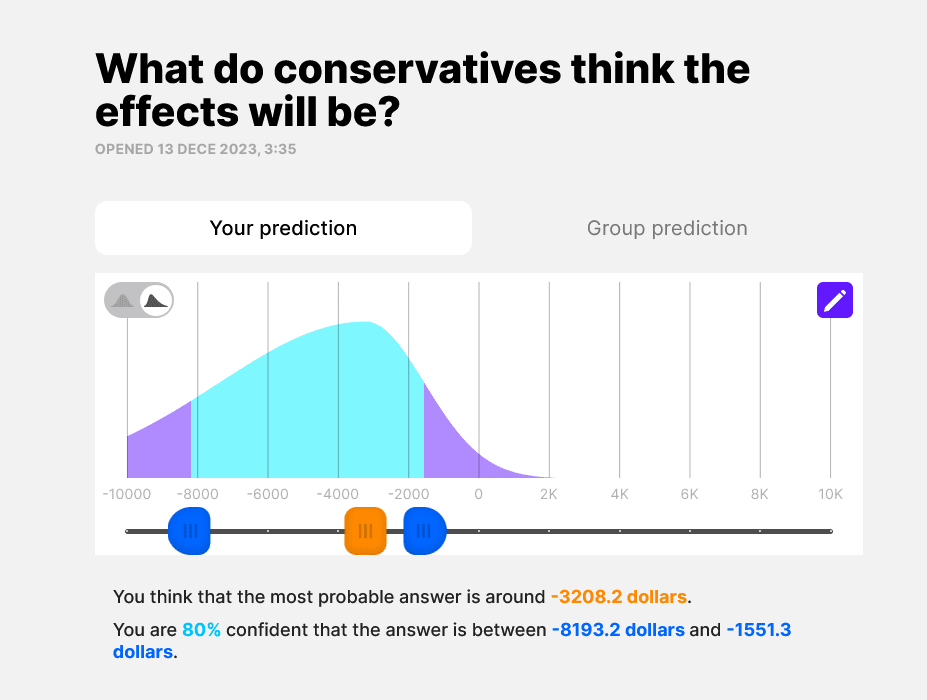TL;DR:
Confido has new features: Interactive calibration curves for binary and numeric questions; asymmetric distributions and user-friendly user and room management. We hope it will help organizations to better coordinate and make strategic decisions.
You can read our previous post about Confido 1.0. You can see all Confido features in detail here. You can play with our demo. You can get your personal or organization workspace for free.
Introduction
We believe that when it comes to important collective strategic questions, it is often useful to replace definite answers (such as yes, no, certainly, impossible) with a nuanced scale (e.g. 0-100% confidence), as this allows us to capture much better not only what we think, but also how sure we are about it. And we do not need to have a forecasting question with a clear resolution to take advantage of this principle. Lots of uncertain questions that are valuable to ask and get the nuanced opinion of others are implicit belief questions. (E. g. Overall is this venue better than this other venue for our conference? Knowing this, should we rather focus on priority C instead of A?)
But if we want to be well-calibrated for implicit beliefs questions, we should answer a forecasting question (a question with a clear resolution) from time to time as well and get a calibration check-up we can learn from (for example to clearly see when I think there is 80% chance, the reality is usually 50% chance).
And that's why we've improved the Confido app again. Its newest version includes interactive calibration curves (where you can see how well calibrated you are for both yes/no as well as numeric questions) with detailed explanations, asymmetric distributions, and upgraded user and room management.
Confido offers the highest data security and you can use it for uncertain and very sensitive questions within your org that you do not want to discuss publicly or you do not want to have anyone outside your circle or org access to (not even the Confido team). And you can use it for both resolvable and non-resolvable questions.
Also we design Confido to be intuitive even for people who have not encountered probabilistic thinking in the past (non-forecasters) - so you can share your private questions also with experts outside the “forecasting community.”
Of course you can still use Confido also for personal forecasting and calibration, meetings, tournaments, interactive talks and calibration trainings.
Enjoy!
New features
2.1 Calibration curves
Now you can see your calibration curve for both numeric questions and binary questions in one place. The calibration curve is interactive, so you can also easily investigate all questions in a given confidence range.
Confido allows you not only to compare your calibration with the rest of the group that provided its estimate. You can also see your total calibration (for all questions in your Confido workspace) as well as calibration curves for specific topics (if you place your questions in different rooms according to their topic).
Since we focus also on less experienced forecasters and people, who have never done forecasting before, you can find all explanations of the curve within the app.
2.2 Asymmetric distributions
You can switch from symmetric to asymmetric distributions just by one click.

2.3 User-friendly User Management
New user-management is currently on the main dashboard, so you can access it easily. You can add new permanent members of your workspace as well as external quests (people outside your organization who should have access only to a few questions in the workspace). As a moderator you can now more easily manage their role.

2.4 Advanced room management
If you organize an interactive talk, forecasting tournament of calibration training with lots of questions, you can now organize all room questions in one spot.
Acknowledgements
Despite the fact that the promised funds for the planned project did not arrive and we have not succeeded when applying for a replacement, we have decided to keep improving the app to serve users better. Big thank you to the team that made Confido 2.0 come true in spite of these constraints - Filip Štědronský and Datta Prasad Godbole.


Any chance for a Slack plugin?
@david_reinstein It's on our roadmap. But because of the lack of funding, I can't say when we can make it happen.